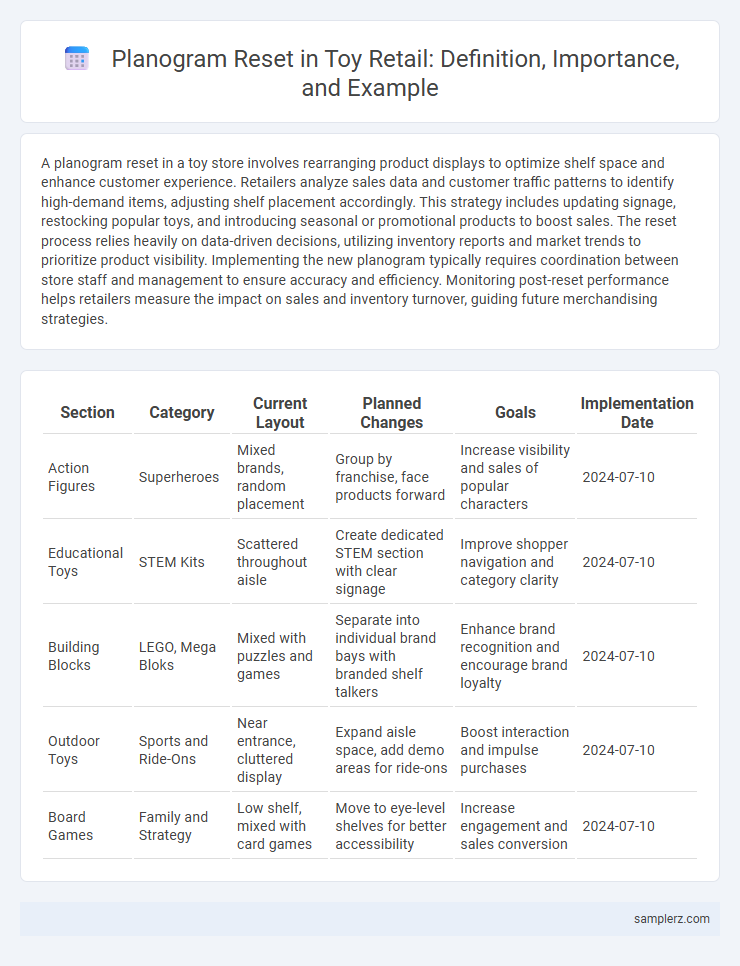A planogram reset in a toy store involves rearranging product displays to optimize shelf space and enhance customer experience. Retailers analyze sales data and customer traffic patterns to identify high-demand items, adjusting shelf placement accordingly. This strategy includes updating signage, restocking popular toys, and introducing seasonal or promotional products to boost sales. The reset process relies heavily on data-driven decisions, utilizing inventory reports and market trends to prioritize product visibility. Implementing the new planogram typically requires coordination between store staff and management to ensure accuracy and efficiency. Monitoring post-reset performance helps retailers measure the impact on sales and inventory turnover, guiding future merchandising strategies.
Table of Comparison
| Section | Category | Current Layout | Planned Changes | Goals | Implementation Date |
|---|---|---|---|---|---|
| Action Figures | Superheroes | Mixed brands, random placement | Group by franchise, face products forward | Increase visibility and sales of popular characters | 2024-07-10 |
| Educational Toys | STEM Kits | Scattered throughout aisle | Create dedicated STEM section with clear signage | Improve shopper navigation and category clarity | 2024-07-10 |
| Building Blocks | LEGO, Mega Bloks | Mixed with puzzles and games | Separate into individual brand bays with branded shelf talkers | Enhance brand recognition and encourage brand loyalty | 2024-07-10 |
| Outdoor Toys | Sports and Ride-Ons | Near entrance, cluttered display | Expand aisle space, add demo areas for ride-ons | Boost interaction and impulse purchases | 2024-07-10 |
| Board Games | Family and Strategy | Low shelf, mixed with card games | Move to eye-level shelves for better accessibility | Increase engagement and sales conversion | 2024-07-10 |
Understanding Planogram Resets: Why Toy Stores Need Them
Planogram resets in toy stores involve strategically rearranging product displays to optimize space utilization and enhance customer engagement. These resets address shifts in consumer preferences, seasonal trends, and new product launches to boost sales and inventory turnover. Effective planogram resets ensure toys are presented in an organized, visually appealing manner that aligns with the latest market demands and maximizes retail performance.
Key Objectives of a Toy Store Planogram Reset
A toy store planogram reset aims to enhance product visibility and optimize shelf space to boost sales and improve customer experience. Key objectives include aligning merchandise placement with current consumer trends, increasing accessibility to high-demand toys, and promoting seasonal or promotional items effectively. Efficient categorization and strategic positioning help drive impulse purchases and maximize overall store profitability.
Step-by-Step Preparation for a Planogram Reset
Start by analyzing sales data and customer behavior to identify underperforming product categories and optimize shelf space. Conduct a detailed inventory audit and update SKU lists to ensure accurate stock placement according to the new planogram. Collaborate with store staff to schedule the reset during low-traffic hours, communicate layout changes, and prepare necessary fixtures and signage for a smooth transition.
Gathering and Analyzing Sales Data for Effective Resets
Gathering and analyzing sales data plays a crucial role in planogram resets at toy stores by identifying high-performing products and underperforming items to optimize shelf space. Using point-of-sale data and customer purchasing patterns allows retailers to adjust product placement, ensuring popular toys gain maximum visibility and boosting overall sales. Effective data-driven resets align inventory with consumer demand, enhancing both customer satisfaction and revenue growth.
Example Planogram Layouts for Popular Toy Categories
Example planogram layouts for popular toy categories in a toy store emphasize strategic product placement to maximize visibility and sales. Action figures are often arranged at eye level to attract children, while educational toys are grouped near the checkout area to encourage impulse buys. Seasonal items and trending toys are positioned prominently on endcaps to capture shopper attention and drive category growth.
Seasonal Reset Strategies for Toy Store Merchandising
Seasonal reset strategies in toy store merchandising involve reorganizing product displays to align with upcoming holidays and events, such as back-to-school, Halloween, and Christmas, boosting shopper engagement and sales. Effective planogram resets prioritize high-demand seasonal toys, optimize shelf space for visibility, and incorporate themed signage to capture customer attention. Leveraging data on past seasonal sales trends enhances inventory allocation and maximizes revenue during peak shopping periods.
Implementing Planogram Changes: A Real-World Example
Implementing planogram changes in a toy store involved rearranging shelves to highlight best-selling items like LEGO sets and action figures, increasing visibility and accessibility. Seasonal toys were strategically placed at eye level to boost impulse purchases, while clearance items were grouped to create a dedicated sale section, driving inventory turnover. Sales data showed a 15% increase in revenue within two months, validating the effectiveness of the planogram reset.
Maximizing Shelf Impact with Strategic Product Placement
Strategic product placement during a toy store planogram reset enhances shelf impact by grouping high-demand items at eye level to drive impulse purchases and optimize sales. Incorporating seasonal bestsellers and popular character-themed toys in focal zones boosts customer engagement and increases turnover rates. Utilizing color blocking and size variations further attracts attention and streamlines the shopping experience, maximizing overall retail performance.
Involving Staff in the Reset Process: Best Practices
Involving staff in the toy store planogram reset ensures practical insights on product placement based on daily customer interactions, enhancing merchandising effectiveness. Training employees on visual merchandising principles and encouraging feedback fosters ownership and improves adherence to the new layout. Incorporating staff suggestions during the reset process increases efficiency, reduces errors, and optimizes shelf organization for popular toys and seasonal items.
Evaluating the Success of a Toy Store Planogram Reset
Sales data analysis and customer traffic patterns provide key indicators when evaluating the success of a toy store planogram reset. Tracking product placement effectiveness through increased sales of featured items and reduced out-of-stock incidents highlights the planogram's impact on inventory management. Customer feedback and visual merchandising audits further assess the reset's influence on shopper engagement and overall store performance.

example of planogram reset in toy store Infographic
 samplerz.com
samplerz.com